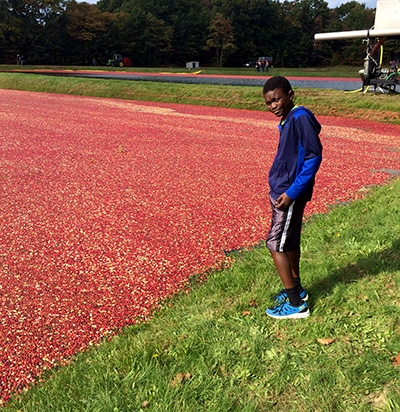Cranberry harvest in Michigan
What I learned about harvesting cranberries after visiting DeGrandchamp Farms in South Haven, Michigan, to see the cranberry harvest.

This is a busy agritourism time of year for Michigan. While families head to pumpkin patches and apple orchards, the over-21 crowds head to vineries and north to see the trees in their array of crimson, gold and orange. My family headed south to DeGrandchamp Farms in South Haven, Michigan, to see the cranberry harvest.
DeGrandchamp Farms started off as a 12-acre blueberry farm in 1958 and is now one of the leading producers of blueberries in Michigan. They ventured into cranberry production in 1994. Cranberries and blueberries take almost identical growing conditions of sandy, acidic soil. This was a perfect fit. Blueberry season is in the summer, with harvest July through early August. Cranberries are a fall crop, harvested September through October. To read more about farm and the annual fall cranberry harvest day, which hosts over a thousand visitors, go to the DeGrandchamp Farms website.
I learned a few things from Mike DeGrandchamp on my first tour of a cranberry farm. Cranberries grow on very low-growing evergreen creeping shrubs/vines. Bees pollinate their dark pink flowers that have very distinct reflexed petals, which simply means they curve backward. This leaves the style and stamens fully exposed and pointing forward. The flowers look similar to cranes, once called “crane berries,” hence the name cranberry. The berries are larger than the leaves of the plant, and are initially light green, turning white and then ripening to a vibrant red.
DeGrandchamp said, “This year’s harvest is a little late with the warm fall weather. When we see brightly colored trees, we get brightly colored red fruit.” Interestingly, some processors do not want all dark red fruit as it turns dark, almost black, when processed. DeGrandchamp also stated fresh berries with a good mix of colors will turn bright red once frozen. Cranberries have an acidic taste that can overwhelm their sweetness.
Cranberries are in the same genus as blueberries, Vaccinium. They are traditionally planted in wetland bog areas or areas with a very high water table. Cranberries do not grow in water; the beds are flooded for harvest and winter protection. Cranberries can be planted in upland areas if winter protection is provided and the soil requirements are met.
 According to DeGrandchamp, Wisconsin—the largest cranberry-producing state, growing 57 percent of the cranberries in the U.S.—calls their cranberry beds “bogs.” In Massachusetts, the second largest producer, they call their cranberry beds “marshes,” at DeGrandchamp Farms, they call their cranberry beds “beds.” They grow over 40 acres of cranberries and some of their beds are as big as 5 acres.
According to DeGrandchamp, Wisconsin—the largest cranberry-producing state, growing 57 percent of the cranberries in the U.S.—calls their cranberry beds “bogs.” In Massachusetts, the second largest producer, they call their cranberry beds “marshes,” at DeGrandchamp Farms, they call their cranberry beds “beds.” They grow over 40 acres of cranberries and some of their beds are as big as 5 acres.
The most common way to harvest cranberries is a wet harvest. Watching the wet harvest of cranberries was like visiting the set of an Ocean Spray commercial. During a wet harvest, the fruit is “beaten” off the vine using a specialized harvester while the beds are flooded. The floating fruit is then corralled and loaded onto trucks for delivery to a receiving station. Wet harvested fruit at DeGrandchamps is used for processed cranberry products like juice and sauce. Most of DeGrandchamp’s cranberries are cleaned and shipped to Ocean Spray and can be found in any of their products.
They also dry harvest fruit where it is “combed” from the vine using a mechanized picking machine. No water is involved during this process. The fruit is loaded into bins and sent to their warehouse where it is cleaned, milled and packaged as fresh fruit. They offer fresh cranberries in their farm market in October along with other processed cranberry products, including salsa, butters and, my favorite, cranberry mustard.
To learn more about cranberries, read the Michigan State University Extension article “Cranberries: They are good for you and grown in Michigan” and “Cranberries and their many uses.”
For more about the potential of growing cranberries, read “Michigan Takes a Serious Look at Cranberries” by Fruit Growers News.



 Print
Print Email
Email




